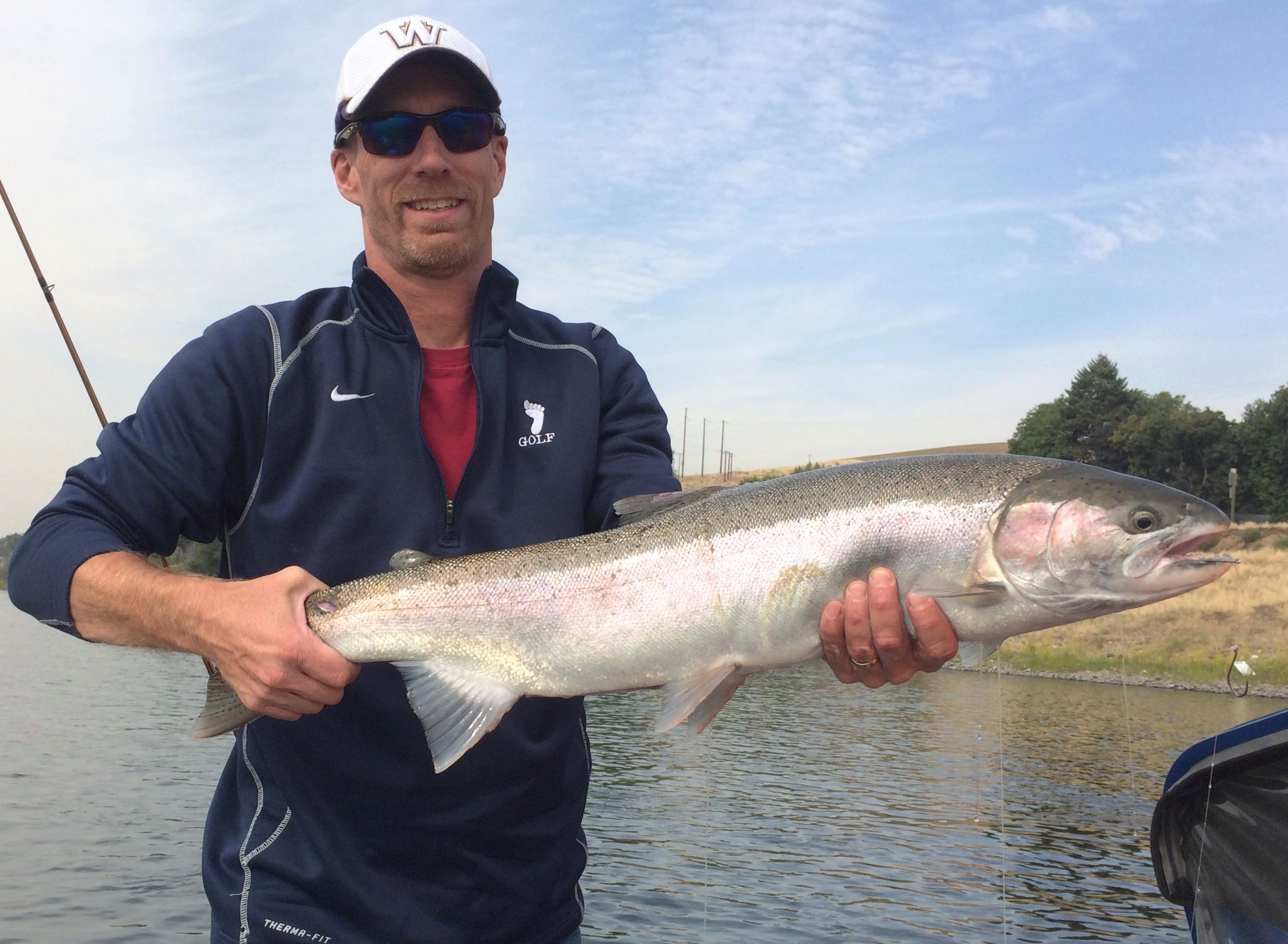Fall chinook hitting at Snake-Clearwater confluence

UPDATED 11:25 with photo of the big steelhead Shawn Barron caught on Clearwater River (inset) shortly after his son, Tyler, caught the big fall chinook (above). That’s what I call a good day of fishing!
FISHING — The nice thing about fishing in the lower Clearwater River this time of year is that the fish you catch are either big or bigger.
Steelhead have been attracting anglers to the waters near Lewiston since July, when the fish started trickling over Lower Granite Dam in decent numbers and up the Snake River toward Idaho.To date, more than 22,000 steelhead have passed over Lower Granite Dam (since June 1) and the fish continue to swim over their last Snake River hurdle at the rate of about 1,300 a day.

But now fall chinook are showing in bigger numbers as a forecast record run pushes into the Columbia River system. Indeed, the numbers of fall chinook over Lower Granite is higher than the number of steelhead.
“We are anticipating that the fall chinook salmon returning run to Idaho will be the second largest we have seen in quite some time last year was the largest,” said Joe DuPont, Idaho Fish and Game Department regional fisheries manager in Lewiston.
“We are expecting around 50,000 adults to pass over Lower Granite Dam and what is even more exciting is this year the majority of the adult fish are three-ocean fish that typically range from 18-22 pounds.
“On average, more than 2,000 adult chinook a day have been passing over Lower Granite Dam for the past week. Soon we should exceed 3,000 adult chinook a day. Catch rates for Chinook have been quite slow, but they should pick up with all these fish starting to move in.”
Steelhead fishing also has been fairly slow, he said, noting that surveys pegged success at 20 hours per fish in the Snake River and Clearwater River downstream of Memorial Bridge where fish can be harvested.
But expect these catch rates to improve as more fish move into Idaho.
“Steelhead fishing in the catch-and-release area of the Clearwater River (upstream of Memorial Bridge) has been fairly good with catch rates around 5 to 6 hours a fish,” DuPont said.
“One interesting this about this year’s A run is that over half the fish that have passed over Lower Granite Dam are two-ocean fish running 9-13 pounds,” he said. The A run is the term used for the earlier arriving steelhead that are typically dominated by one-ocean fish and are mainly destined for the Salmon and Grande Ronde rivers and up the Snake to Hells Canyon Dam.
“So, although the catch rates haven’t been all that great, people have been pleased with the size of the fish they are catching. Now that the B run (later arriving and generally larger two-ocean steelhead bound mostly for the Clearwater River Basin) is just starting to reach Idaho, the size of the fish should just get bigger.
Fall chinook anglers in Idaho often wonder why “wild” fish are protected when they seem to catch more “unclipped” salmon than “clipped” salmon produced at hatcheries. DuPont explains:
- Only about 30% of the chinook passing over Lower Granite Dam are fin-clipped. That is because a lot of wild fish are returning and because around half the hatchery fall chinook released in Idaho are clipped. This was done to help build the run when numbers were low. Thus, anglers will have to catch around four unmarked fish for every clipped fish that can be harvested.
Another question commonly asked: “Why can’t anglers harvest fall chinook upstream of Memorial Bridge?” DuPont explains:
- First, only about 25 percent of the hatchery fish released into the Clearwater River are clipped. Thus, when you mix in the wild fish only about 15 percent of the fish are clipped. That doesn’t leave a lot of fish to be harvested. This clip rate is set until 2017. Discussion will occur to decide what the new clip rate will be starting in 2018.
- Second, the Clearwater River is a very popular place to catch-and-release steelhead, and has been for many years. Anglers come from all over the nation to fish this unique fishery. Opening a fall chinook season at the same time as this catch-and-release steelhead season occurs would cause significant changes in the dynamics of this fishery (more anglers and more boats). Many steelhead anglers say they are not in support of this.
- Finally, the Nez Perce Tribe is largely responsible for rebuilding the fall chinook run in Idaho. Because most of the Clearwater River is in the Nez Perce Tribal Reservation, we need to be considerate of their concerns and interests before moving forward with a fishery that targets fall chinook in this area. We will have discussions with the Tribe about this when we feel the time is appropriate.
* This story was originally published as a post from the blog "Outdoors Blog." Read all stories from this blog